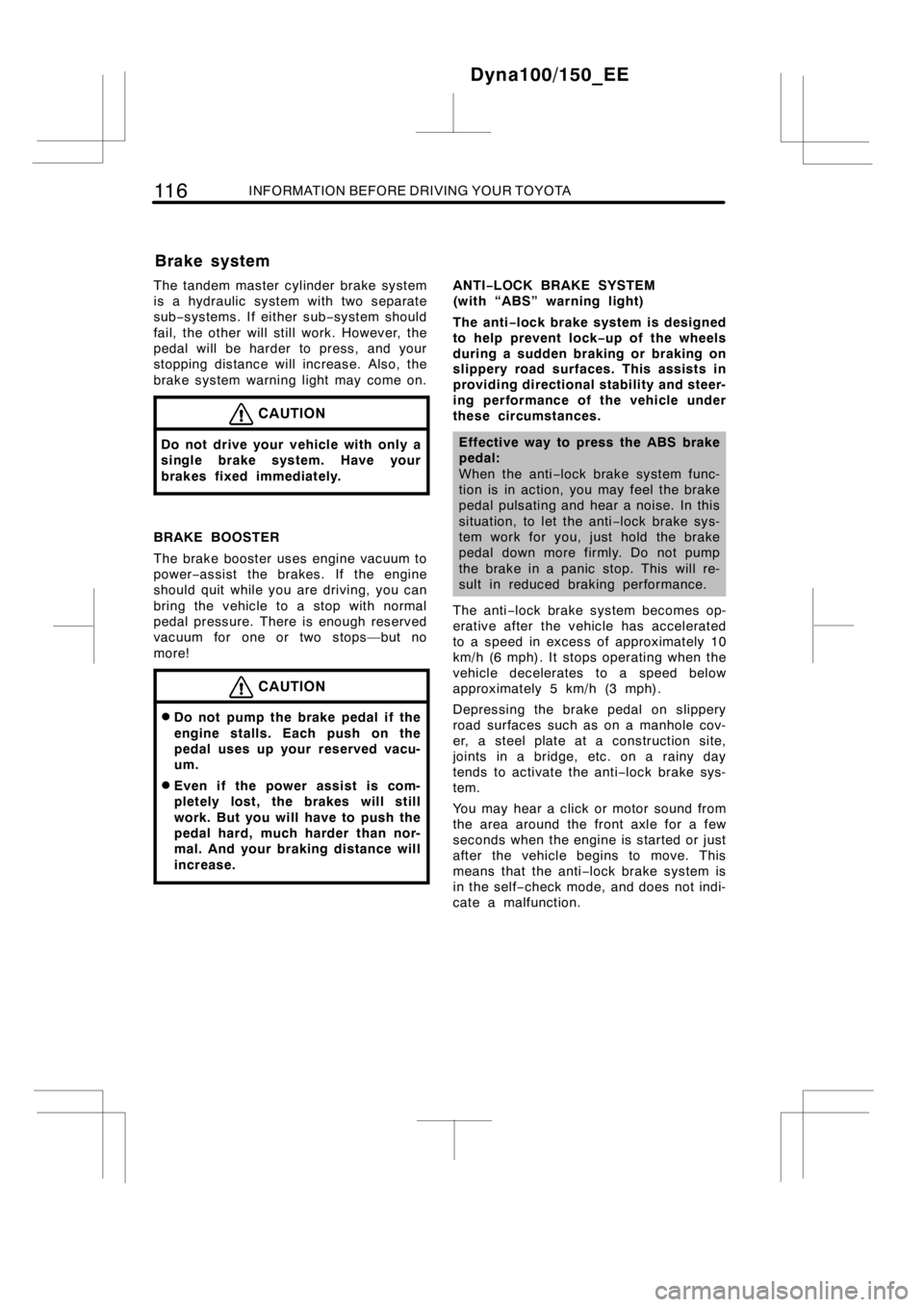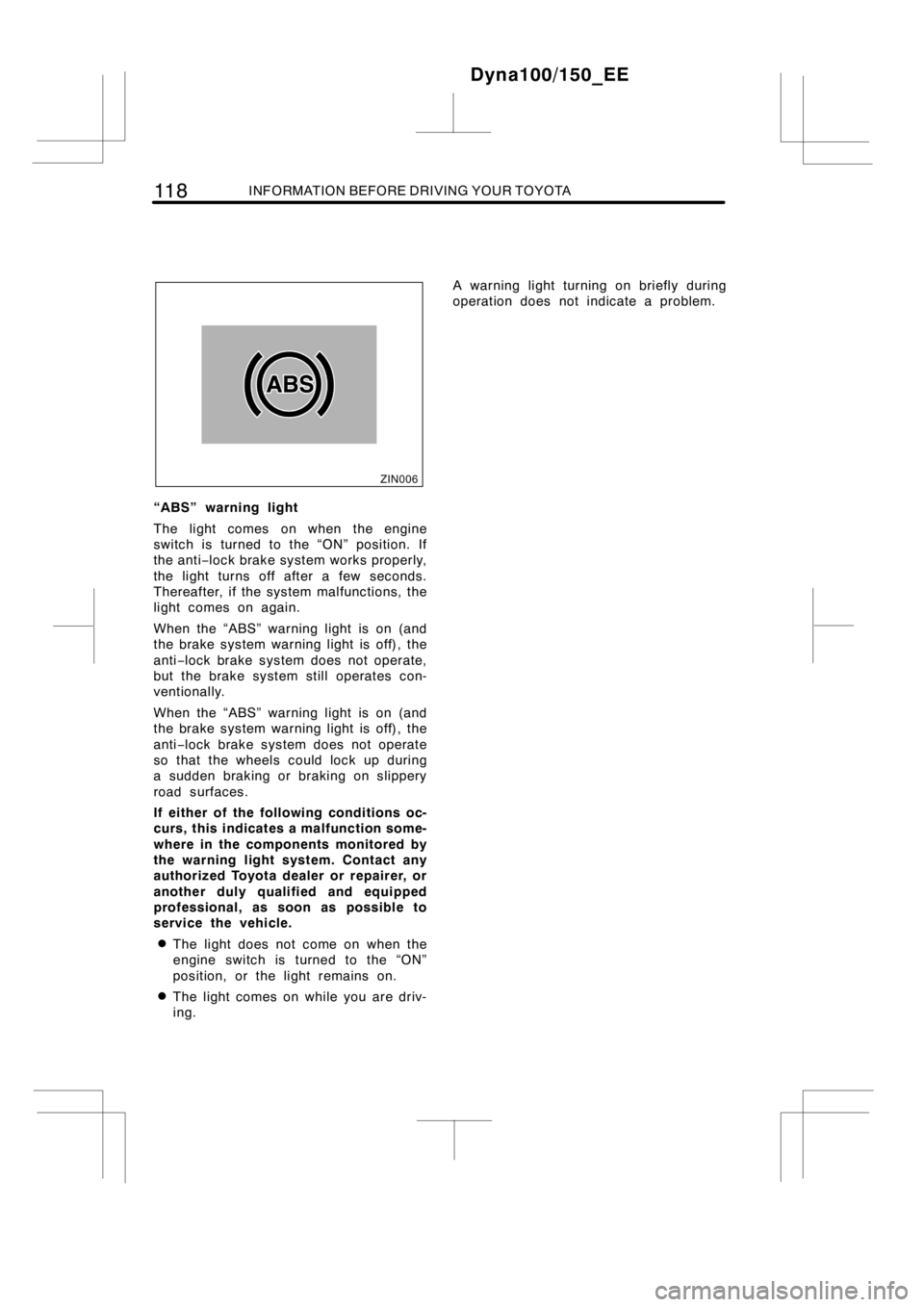Page 88 of 232
82ENGINE (IGNITION) SWITCH, TRANSMISSION AND PARKING BRAKE
When parking, firmly apply the parking
brake to avoid inadvertent creeping.
To set: Pull up the lever. For better hold-
ing power, first depress the brake pedal
and hold it while setting the parking
brake.
To release: Pull up the lever slightly (1),
press the lock release button (2), and low-
er (3).
To remind you that the parking brake is
set, the parking brake reminder light in
the instrument panel remains on until you
release the parking brake.
CAUTION
Before driving, be sure the parking
brake is fully released and the park-
ing brake reminder light is off.
Dyna100/150_EE
Parking brake
Page 95 of 232

AIR CONDITIONING SYSTEM89
DTo cool off your Toyota after it has
been parked in the hot sun, drive with
the windows open for a few minutes.
This vents the hot air, allowing the air
conditioning to cool the interior more
quickly.
DMake sure the air intake grilles in front
of the windshield are not blocked (by
leaves or snow, for example).
DKeep the area under the front seats
clear to allow air to circulate through-
out the vehicle.
DOn cold days, set the fan speed to
high for a minute to help clear the
intake ducts of snow or moisture. This
can reduce the amount of fogging on
the windows.
DWhen driving on dusty roads, close all
windows. If dust thrown up by the ve-
hicle is still drawn into the vehicle after
closing the windows, it is recommended
that the air intake selector be set to
FRESH and the fan speed selector to
any setting except “OFF”.
DIf following another vehicle on a dusty
road, or driving in windy and dusty
conditions, it is recommended that the
air intake selector be temporarily set to
RECIRCULATE, which will close off the
outside passage and prevent outside
air and dust from entering the vehicle
interior.
DDuring use, various odors from inside
and outside the vehicle may enter into
and accumulate in the air conditioning
system. This may then causeodor to
be emitted from the vents.
DTo reduce potential odors from occur-
ring:
It is recommended that the air condi-
tioning system be set to outside air
mode prior to turning the vehicle off.
CAUTION
To prevent the windshield from fog-
ging up, do not select the windshield
air outlets during cool air operation
in extremely humid weather. The dif-
ference between the temperature of
the outside air and that of the wind-
shield can cause the outer surface of
the windshield to fog up, blocking
your vision.
NOTICE
To prevent battery discharge, do not
leave the air conditioning system on
longer than necessary when the en-
gine is stopped.
Heating
For best results, set controls to:
Fan speed—Any setting except “OFF”
Temperature—To w a r d sWARM
(red zone)
Air intake—FRESH(outside air)
Air flow—FLOOR
Air conditioning—OFF
DFor quick heating, set the temperature
selector lever to the right end position
and select recirculated air mode for a
few minutes. To keep the windows from
fogging after the vehicle interior has
been warmed, select fresh air mode.
DPress the “A/C” button on for dehumidi-
fied heating.
DChoose floor/windshield air flow to heat
the vehicle interior while defrosting the
windshield.
Dyna100/150_EE
Operating tips
Page 106 of 232
100OTHER EQUIPMENT
Cigarette lighter and front ashtray
Rear ashtray
CIGARETTE LIGHTER
To use the cigarette lighter, press it in.
After it finishes heating up, it automati-
cally pops out ready for use.
If the engine is not running, the engine
switch must be in the “ACC” position.
Do not hold the cigarette lighter pressed
in.
Use a Toyota genuine cigarette lighter or
equivalent for replacement.ASHTRAYS
To use the ashtray, pull it out.
When finished with your cigarette, thor-
oughly extinguish it in the ashtray to pre-
vent other cigarette butts from catching
fire. After using the ashtray, close the lid
completely.
To remove the ashtray, press down on the
lock spring plate and pull out.
CAUTION
To reduce the chance of injury in
case of an accident or sudden stop
while driving, always completely close
the ashtray after use.
Dyna100/150_EE
Cigarette lighter and ashtrays
Page 109 of 232
OTHER EQUIPMENT103
Left−hand drive vehicles
Right−hand drive vehicles
To use the center console box:
Left−hand drive vehicles—Pull the lock
release lever (1) up and lower the cen-
ter seatback. Raise the console box lid
while pressing the lock release lever
(2).
Right−hand drive vehicles—Pull the lock
release lever up and lower the center
seatback.
CAUTION
To avoid death or serious injury:
DDo not sit on the seatback table.
DAlways keep the console box closed
while driving.
Dyna100/150_EE
Center console box
Page 122 of 232

11 6INFORMATION BEFORE DRIVING YOUR TOYOTA
The tandem master cylinder brakesystem
is a hydraulic system with two separate
sub−systems. If either sub−system should
fail, the other will still work. However, the
pedal will be harder to press, and your
stopping distance will increase. Also, the
brake system warning light may come on.
CAUTION
Do not drive your vehicle with only a
single brake system. Have your
brakes fixed immediately.
BRAKE BOOSTER
The brake booster uses engine vacuum to
power−assist the brakes. If the engine
should quit while you are driving, you can
bringthevehicletoastopwithnormal
pedal pressure. There is enough reserved
vacuum for one or two stops—but no
more!
CAUTION
DDo not pump the brake pedal if the
engine stalls. Each push on the
pedal uses up your reserved vacu-
um.
DEven if the power assist is com-
pletely lost, the brakes will still
work. But you will have to push the
pedal hard, much harder than nor-
mal. And your braking distance will
increase.
ANTI−LOCK BRAKE SYSTEM
(with “ABS” warning light)
The anti−lock brake system is designed
to help prevent lock−up of the wheels
during a sudden braking or braking on
slippery road surfaces. This assists in
providing directional stability and steer-
ing performance of the vehicle under
these circumstances.
Effective way to press the ABS brake
pedal:
When the anti−lock brake system func-
tion is in action, you may feel the brake
pedal pulsating and hear a noise. In this
situation, to let the anti−lock brake sys-
tem work for you, just hold the brake
pedal down more firmly. Do not pump
the brake in a panic stop. This will re-
sult in reduced braking performance.
The anti−lock brake system becomes op-
erative after the vehicle has accelerated
to a speed in excess of approximately 10
km/h (6 mph). It stops operating when the
vehicle decelerates to a speed below
approximately 5 km/h (3 mph).
Depressing the brake pedal on slippery
road surfaces such as on a manhole cov-
er, a steel plate at a construction site,
joints in a bridge, etc. on a rainy day
tends to activate the anti−lock brake sys-
tem.
You may hear a click or motor sound from
the area around the front axle for a few
seconds when the engine is started or just
after the vehicle begins to move. This
means that the anti−lock brake system is
in the self−check mode, and does not indi-
cate a malfunction.
Dyna100/150_EE
Brake system
Page 123 of 232

INFORMATION BEFORE DRIVING YOUR TOYOTA11 7
When the anti−lock brake system is ac-
tivated, the following conditions may
occur. They do not indicate a malfunc-
tion of the system:
DYou may hear the anti−lock brake sys-
tem operating and feel the brake pedal
pulsating and the vibrations of the ve-
hicle body and steering wheel. You
may also hear the motor sound from
the area around the front axle even
after the vehicle is stopped.
DAt the end of the anti−lock brake sys-
tem activation, the brake pedal may
movealittleforward.
CAUTION
Do not overestimate the anti−lock
brake system: Although the anti−lock
brake system assists in providing ve-
hicle control, it is still important to
drive with all due care and maintain
a moderate speed and safe distance
from the vehicle in front of you, be-
cause there are limits to the vehicle
stability and effectiveness of steering
wheel operation even with the anti−
lock brake system on.
If tire grip performance exceeds its
capability, or if hydroplaning occurs
during high speed driving in the rain,
the anti−lock brake system does not
provide vehicle control.
Anti−lock brake system is not de-
signed to shorten the stopping dis-
tance: Always drive at moderate
speed and maintain a safe distance
from the vehicle in front of you.
Compared with vehicles without an
anti−lock brake system, your vehicle
may require a longer stopping dis-
tance in the following cases:
DDriving on rough, gravel or snow−
covered roads.
DDriving with tire chains installed.
DDriving over the steps such as the
joints on the road.
DDriving on roads where the road
surface is pitted or has other differ-
ences in surface height.
Install all tires of specified size at
appropriate pressure: The anti−lock
brake system detects vehicle speeds
using the speed sensors for respec-
tive wheels’ turning speeds. The use
of tires other than specified may fail
to detect the accurate turning speed
resulting in a longer stopping dis-
tance.
Dyna100/150_EE
Page 124 of 232

11 8INFORMATION BEFORE DRIVING YOUR TOYOTA
“ABS” warning light
The light comes on when the engine
switch is turned to the “ON” position. If
the anti−lock brake system works properly,
the light turns off after a few seconds.
Thereafter, if the system malfunctions, the
light comes on again.
When the “ABS” warning light is on (and
the brake system warning light is off), the
anti−lock brake systemdoes not operate,
but the brake system stilloperates con-
ventionally.
When the “ABS” warning light is on (and
the brake system warning light is off), the
anti−lock brake systemdoes not operate
so that the wheels could lock up during
a sudden braking or braking on slippery
road surfaces.
If either of the following conditions oc-
curs, this indicates a malfunction some-
where in the components monitored by
the warning light system. Contact any
authorized Toyota dealer or repairer, or
another duly qualified and equipped
professional, as soon as possible to
service the vehicle.
DThe light does not come on when the
engine switch is turned to the “ON”
position, or the light remains on.
DThe light comes on while you are driv-
ing.A warning light turning on briefly during
operation does not indicate a problem.
Dyna100/150_EE
Page 128 of 232
122INFORMATION BEFORE DRIVING YOUR TOYOTA
The engine number is stamped on the
engine block as shown.
CAUTION
Do not modify the suspension/chassis
with lift kits, spacers, springs, etc. It
can cause dangerous handling charac-
teristics, resulting in loss of control.
Dyna100/150_EE
—Engine number Suspension and chassis